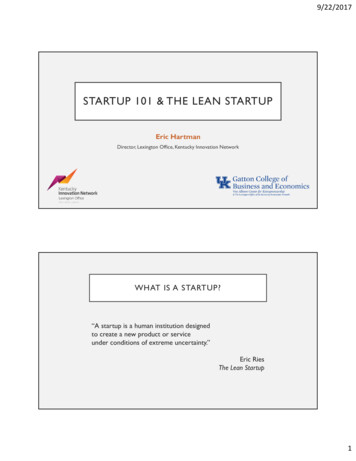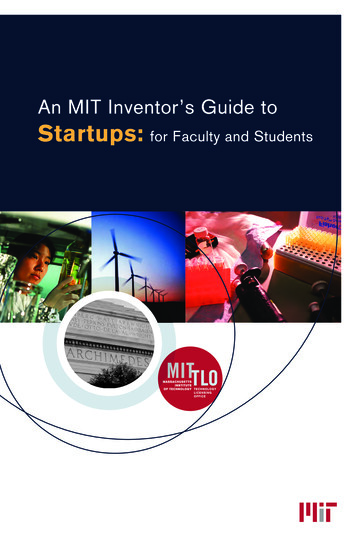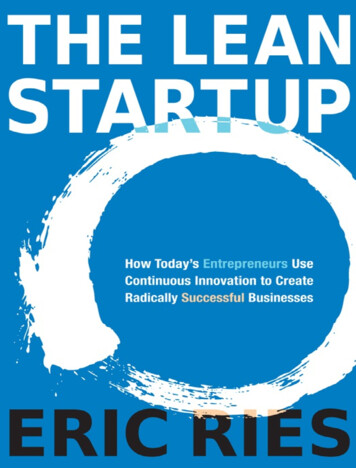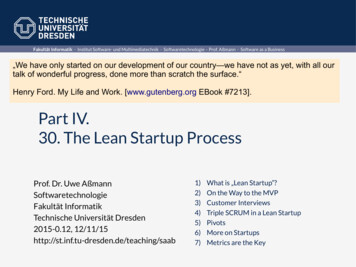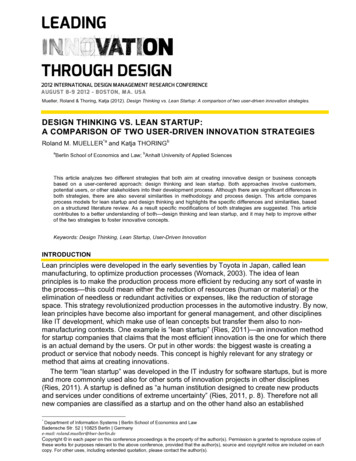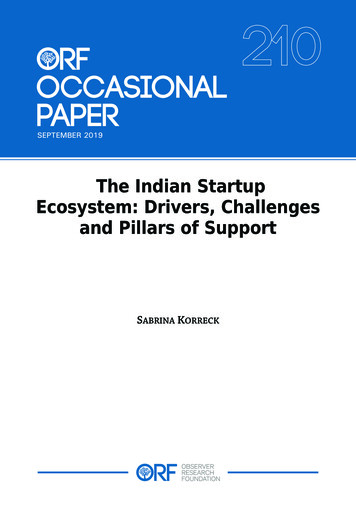
Transcription
SEPTEMBER 2019The Indian StartupEcosystem: Drivers, Challengesand Pillars of SupportSABRINA KORRECK
The Indian Startup Ecosystem:Drivers, Challenges and Pillarsof SupportSABRINA KORRECK
ABOUT THE AUTHORDr. Sabrina Korreck is a Senior Fellow at Observer ResearchFoundation. Her research focuses on the digital economy and she tracksdevelopments in startup ecosystems, particularly in South Asia andEurope. She previously held research positions at the Chair ofManagement and Digital Markets at University of Hamburg as well asthe Hertie School of Governance, and worked as a business analyst inthe Berlin startup scene.ISBN: 978-93-89094-77-0 2019 Observer Research Foundation. All rights reserved. No part of this publication may bereproduced or transmitted in any form or by any means without permission in writing from ORF.
The Indian Startup Ecosystem:Drivers, Challenges andPillars of SupportABSTRACTIn recent years, startups have been receiving increased attention inmany parts of the world. In India, the number of startups has increasedfast and more support has become available in all dimensions. Thispaper analyses the current state of the Indian startup ecosystem andhas three goals: to provide an understanding of the growth drivers andmotivations of Indian startup founders; identify challenges facing thesestartups; and outline the pillars in place that support them. The analysisuses data collated from semi-structured interviews with startupfounders, investors, and representatives of support organisations. Inaddition, a survey of relevant literature strengthens the robustness ofthe findings.Attribution: Sabrina Korreck, “The Indian Startup Ecosystem: Drivers, Challenges andPillars of Support”, ORF Occasional Paper No. 210, September 2019, Observer ResearchFoundation.ORF OCCASIONAL PAPER # 210SEPTEMBER 20191
THE INDIAN STARTUP ECOSYSTEM: DRIVERS, CHALLENGES AND PILLARS OF SUPPORT1. INTRODUCTION#Startups, in India as in many other parts of the world, have receivedincreased attention in recent years. Their numbers are on the rise andthey are now being widely recognised as important engines for growthand jobs generation. Through innovation and scalable technology,startups can generate impactful solutions, and thereby act as vehiclesfor socio-economic development and transformation.The Indian startup ecosystem has evolved dynamically over the lasttwo decades. Some startups were founded in the 2000s, but theecosystem was still immature as only a few investors were active and thenumber of support organisations such as incubators and acceleratorswas limited. Some successful exits occurred in the late 2000s and in thelast ten years, the number of startups increased fast and more supporthas become available in all dimensions. Bangalore has emerged as India’sprimary startup hub, but significant founding activity is also takingplace in Mumbai and the National Capital Region (NCR), as well as some1smaller cities.The aim of this study is to provide a comprehensive understanding ofboth the growth drivers as well as the challenges faced by Indianstartups. Further, the study investigates how the startup ecosystem hasdeveloped over the years and describes where and which kind of supportis available. While the primary focus is on technology-driven startups,# 2In this study, the term ‘startup’ is used in orientation with the definition of thefederal government (Dwivedi, A. B. (2016): The government has finally defined theword ‘startup”. n-startup;accessed: 23.09.2019). Accordingly, startups are understood as entities, which are inthe early stages of setting up their operations and work towards innovation,development, deployment, and commercialization of new products, processes, orservices driven by technology or intellectual property.An exit occurs when an entrepreneur sells his or her shares in the startup to others(e.g. investors or another company).ORF OCCASIONAL PAPER # 210SEPTEMBER 2019
THE INDIAN STARTUP ECOSYSTEM: DRIVERS, CHALLENGES AND PILLARS OF SUPPORTthe study recognises that non-tech, social and micro-entrepreneurshave also come up with innovative ideas and solutions.To provide insights on these issues, a qualitative research wasconducted. Semi-structured interviews were done with experts in theIndian startup ecosystem, including startup founders, investors, andrepresentatives of support organisations (see Annex for more details onthe research methodology, including the list of interviewees). Aliterature review was also carried out to provide further backgroundinformation.The rest of the paper is structured as follows. The second sectionoutlines the key opportunities and growth drivers of India’s startupecosystem, as identified through the interviews. Section 3 then outlinesthe challenges facing startups in India. The penultimate sectiondescribes how the ecosystem has evolved, and where and what kind ofsupport is available to help startups overcome challenges and seizeopportunities. The paper concludes by outlining the imperatives offurther action to support India’s startups.2. STARTUPS IN INDIA: OPPORTUNITIES AND GROWTHDRIVERSStartups do not exist in a vacuum but are part of a broader businessenvironment. Thus, the growth drivers of the Indian startup ecosystemneed to be understood in the context of various factors: earlier economicreforms and current market trends, as well as the impact of technologicalchange and changing attitudes on the part of government, largecompanies, and society overall. This section describes the five keyopportunities and growth drivers which were identified in theinterviews.ORF OCCASIONAL PAPER # 210SEPTEMBER 20193
THE INDIAN STARTUP ECOSYSTEM: DRIVERS, CHALLENGES AND PILLARS OF SUPPORT2.1 Scope and Characteristics of the Indian MarketIndia is often described as “the posterchild of emerging markets” for itsvast commercial potential for startups. In a country with a population ofnearly 1.3 billion people, even niche products can have significantmarket potential. In the 1990s, economic reforms moved India towardsa more market-based economic system. Since this liberalisation, theoverall economic development has been dynamic and as of 2017, theIndian economy had a GDP of US 2.726 trillion.2 With a GDP growth of7.0 percent in 2018,3 India is one of the fastest-growing large economiesin the world. Therefore, the Indian market is perceived as being capableof offering an abundance of opportunities for startups.As the Indian economy continues to grow, incomes and purchasingpower are increasing steadily. Rising consumption is driven by thegrowth of upper-middle income and high-income segments of thepopulation, which will grow from being one in four households today, toone in two households by 2030.4 Along with this, the demographics of thepopulation are another advantage. Half of the country’s population are5below the age of 25 years and the youth is aspirational. The nearly 700million people born through the late 1980s to the 2000s carry material6ambitions and have the ability to spend and make those goals a reality.India’s huge diversity in culture, language, ethnicity and religion hasproved to be both a curse and a blessing for startups. On the one hand, astartup’s understanding of customers is often limited to certain regions,where they know the local language and local people. This makes it hardfor startups to scale their products to customers across the country (seesection 3.2 for further detail). On the other hand, if solutions aresuccessful in addressing the needs of diverse customers pan-India, theycan likely find market uptake in other geographies such as Africa andLatin America, and even the developed world. In addition, many Indian4ORF OCCASIONAL PAPER # 210SEPTEMBER 2019
THE INDIAN STARTUP ECOSYSTEM: DRIVERS, CHALLENGES AND PILLARS OF SUPPORTstartups do not only look at Indian problems, but offer customisedsolutions for markets abroad. For instance, Indian startups often dopilots and serve customers in the United States, where the user base hasa much higher ability to pay.2.2. Technological ChangeThere is a huge need for innovative solutions, particularly those thatalleviate poverty and benefit a large number of people. Given the scale ofIndia and its resource constraints, low-cost, high-impact solutions arerequired. Technology startups play a crucial role in accomplishing this,because of their potential for scalability and exponential growth.Over the last few decades, technological change has reduced the costof building digital products and has provided access to consumermarkets. In the past, companies had to set up physical infrastructure tointeract with customers, which implied high customer acquisition coststhat proved prohibitive for small companies in the same field asestablished corporations. As India improved its digital connectivity,market access barriers have been brought down. The broadbandpenetration is increasing fast and the number of wireline subscribers in2018 is expected to increase by 44 percent over the next four years.7 Thenumber of internet users was pegged at 483 million in 2018 and is8projected to reach 666.4 million in 2025. In addition, the governmentinitiative, “Digital Saksharta Abhiyaan”, was started to promote digitalliteracy and help people become more knowledgeable about the digitalworld.9Startups rely on market access as well as possibilities to identify andcharge customers. Establishing someone’s identity is grit in the wheelsof commerce; as the means for identity verification and digitalpayments have become more widely available in recent years, startupsORF OCCASIONAL PAPER # 210SEPTEMBER 20195
THE INDIAN STARTUP ECOSYSTEM: DRIVERS, CHALLENGES AND PILLARS OF SUPPORTcan serve legions of new customers.10 The Aadhaar biometric ID system,introduced in 2009 and assigning Indian residents a unique identitynumber, has made it easier for companies to validate information abouttheir customers. Successive Indian governments have also activelypromoted both the opening of bank accounts and the expansion ofdigital payments to promote financial inclusion.11 Thus, large parts ofthe population are now able to conduct digital payments, as well asreceive government benefits and subsidies, and therefore become partof the formal economy. Moreover, Aadhaar and the payments systemsare part of the “India Stack”, which is envisioned as a new socialstinfrastructure that will “help propel India into the 21 -century digitaleconomy”.12 Increased financial inclusion, as well as the banknotedemonetisation in 2016, led to a boom of fintech& startups, which was13the top funded sector in 2018.2.3. Increased Political Will and Government SupportThe government under Prime Minister Narendra Modi, who assumedpower in 2014, put digital transformation at the centre of its plans. Thefederal as well as some state governments increasingly recognisestartups as important engines for economic growth. Moreover, startupsare expected to create jobs that will narrow the high unemployment ratein the country. In 2018, startups accounted for 2.64 percent of the totaljobs created in India that year; they are projected to create between200,000 and 250,000 jobs in 2019.14The Modi government has made various efforts to support startups.The flagship initiative, “Startup India”, was initiated by the primeminister in 2016 “to build a strong ecosystem that is conducive for thegrowth of startup businesses, to drive sustainable economic growth and&6Fintech startups work in the field of emerging financial services technologies.ORF OCCASIONAL PAPER # 210SEPTEMBER 2019
THE INDIAN STARTUP ECOSYSTEM: DRIVERS, CHALLENGES AND PILLARS OF SUPPORTgenerate large scale employment opportunities.”15 Measures include afund of INR 100 billion, financial support for incubators, establishmentof tinkering labs, tax benefits, and a simplified recognition process forthe setting-up of businesses, among others.16 So far, 14,036 startupshave been recognised according to the definition of the Department ofIndustrial Policy and Promotion (DIPP); 660 startups have received17business support; and 132 startups have been funded. Some interviewpartners for this paper expressed doubt as to whether ‘Startup India’ hasindeed made impact. However, they see the programme as a good stepoverall.2.4. Companies Increasingly Seek to Engage in Open InnovationIn an increasingly uncertain and fast-moving business environment,large companies face pressures to innovate ever more rapidly. Theirchallenge is twofold: to innovate incrementally to grow their existingbusiness, while understanding ongoing changes in their industry andmaking provisions for more radical innovations. The latter is proving tobe difficult, and more large companies realise that they cannot simplyrely on internally generated knowledge and on building everythingthemselves. As this ‘closed innovation’ paradigm loses its relevance,18more companies turn towards open innovation approaches.Thus, companies in India are increasingly reaching out to startups toincrease their own innovativeness. They enter into exchange andstrategic partnerships with startups, while supporting them with19various corporate-specific resources. These engagements can be20mutually beneficial. While a few years ago, corporate managers neededto be convinced of the benefits of working with startups, there has beena recognisable change in attitudes and many established companiestoday acknowledge the competitive advantages of startups, especially interms of their speed and passion.ORF OCCASIONAL PAPER # 210SEPTEMBER 20197
THE INDIAN STARTUP ECOSYSTEM: DRIVERS, CHALLENGES AND PILLARS OF SUPPORT2.5. Changing Perceptions towards EntrepreneurshipThose who are willing to take risks are the ones who can put ideas intopractice and seize opportunities. Most startup founders in India havestrong intrinsic motivations and report being driven by their passion,curiosity, satisfaction that comes from problem solving, and desire tomake a difference in society. Many Indian founders have previouslyworked at a corporate environment, but despite the stability in those jobsand the benefits of high salaries and other perks, they perceived those jobsas constraining to their creativity. A lack of identification with a corporateculture often leads them to create something on their own, which enablesthem to define their own values and control their own direction.Moreover, a change in perceptions among the broader society isnoticeable. The success stories of remarkable exits and India’s firstunicorns21 have received much media attention. Subsequently, somefounders have become India’s “startup heroes”, contributing to acurrent image of entrepreneurship as “cool” and “glamorous”. Despitesome hype, the social acceptability of entrepreneurial careers is indeedincreasing.3. CHALLENGESThere are typical challenges that startups all over the world strugglewith. Certain obstacles, however, are more peculiar to the Indianbusiness environment. In this study, India was often described as aharsh environment for startups. This section outlines the five keychallenges facing Indian startups.3.1. Building and Scaling an Indian StartupThe challenges faced by Indian startups begin with essentials such ashiring and managing a team, dealing with customers, and developing a8ORF OCCASIONAL PAPER # 210SEPTEMBER 2019
THE INDIAN STARTUP ECOSYSTEM: DRIVERS, CHALLENGES AND PILLARS OF SUPPORTmarketing strategy. In particular, many Indian founders have a technicalbackground and lack business knowledge.For running a startup, a significant amount of working capital isrequired. Many startups, especially at early stages, are bootstrapped, i.e.self-funded through the founders’ own savings, or using capital fromfriends and family. Some startups have enough paying customers, sothat they are or become self-sustaining through the revenue and profitsthey generate and are able to grow organically. Thus, while not everystartup needs external investment, many of them start looking forinvestors as they plan to scale their business. However, finding theright investor and raising funds is difficult, even if they have receivedpositive responses on their product and have some proven marketvalidation.3.2. Diversity and the Digital DivideIn general, an information gap exists between those who providesolutions and those who are supposed to use them. In order to buildsuccessful products, startups need to bridge this gap and develop an indepth understanding of the customers and their needs. This isparticularly difficult in the Indian context: India is a highly diversecountry with a plethora of cultures, languages, ethnicities and religions.Because Indian customers are equally diverse, the startups’understanding of them is often limited to certain regions, which theyknow well and where they know local people to work with. In that sense,comparative advantages are linked to specific regions. Therefore,building up a pan-Indian startup is more difficult, because they havelittle understanding of customers in other regions.In addition, there is a disconnect between the startup founders andthe customers, for whom they aim to build products. Most startupORF OCCASIONAL PAPER # 210SEPTEMBER 20199
THE INDIAN STARTUP ECOSYSTEM: DRIVERS, CHALLENGES AND PILLARS OF SUPPORTfounders are well-educated and come from well-off backgrounds inurban metro cities. However, as nearly 70 percent of the Indianpopulation live in rural areas,22 the customers of the mass market tend tocome from low-income backgrounds in villages. Due to different livingenvironments, startups often have an insufficient understanding of thecustomers and their needs.3.3. Taking Products to Market and Low Willingness to PayA further challenge for startups is to take their products to the market asIndian markets appear difficult to penetrate. One reason is thecompetitive landscape: Often, many firms are already present and manymore enter the market, including copycats. A second reason is thatstartups are at a disadvantage compared to large companies. On the onehand, this is due to the fact that big market players are more capable ofdealing with bureaucratic regulations. On the other hand, publicprocurement is seen as weak and government prefers to sign contractswith established companies. However, if startups are promoted by largecompanies (for instance, through partnering with them in the contextof their open innovation initiatives), they may find it easier to capture amarket. A third reason is that communication with and retention ofcustomers takes time and effort. Convincing Indian customers isdifficult, especially if the startup develops innovative products andcaters to new market segments.Furthermore, it is hard for startups to generate willingness to pay fortheir products and services. Despite increasing incomes, the Indiancustomer base continues to be price-sensitive and has little willingnessto pay for products and services. Often customers expect discounts, orbuy cheaper versions from China. Therefore, startups face the challengeof building affordable solutions, which is sometimes done at theexpense of quality. For this reason, many businesses are volume driven,10ORF OCCASIONAL PAPER # 210SEPTEMBER 2019
THE INDIAN STARTUP ECOSYSTEM: DRIVERS, CHALLENGES AND PILLARS OF SUPPORTwith marginal returns. For those startups which do not chargecustomers through means of digital payment, collecting and ensuringtimely payment can be another issue.3.4. Hiring Qualified EmployeesFor many job-seekers, joining a startup as an employee is not anattractive career option, due to the inherent risk that the startup mightfail. Instead, the majority prefer to work for large corporations, whichpromise more stable jobs. In addition, startups can rarely compete withthe reputation and compensation structures which large companies canoffer. Many of those who start working for startups, switch toestablished companies after a few years. Job changes in the oppositedirection occur less likely, because many get used to the benefits of acorporate job.A second reason is that many job applicants are not sufficientlyskilled. Startups see a gap between the knowledge taught to students incolleges and the knowledge needed for the jobs, especially in sectors inwhich technologies change at a fast pace. Because they have littleawareness of industry needs, fresh graduates are usually not readilyemployable from the beginning. As a consequence, when hiring newstaff, startups have to invest significant amount of time and cost to trainnew employees.A third factor is that a significant number of highly qualifiedspecialists move abroad for jobs. At the same time, and in contrast tomany other startup hubs globally, Indian startups are yet to attractinternational talent. Bureaucracy and visa requirements make itdifficult to hire employees from outside India and expatriates aremore attracted to places like Singapore, where the living standard ishigher.ORF OCCASIONAL PAPER # 210SEPTEMBER 201911
THE INDIAN STARTUP ECOSYSTEM: DRIVERS, CHALLENGES AND PILLARS OF SUPPORT3.5. Complex Regulatory EnvironmentThe government of India has introduced policies that aim to ease thebusiness environment for startups. However, the present regulatoryframework in which startups operate is widely seen as difficult,inefficient and unpredictable. Indeed, the World Bank Ease of DoingBusiness index ranks India 77th of 190 countries; the country is 137thof 190 countries in the World Bank Starting a Business Ranking index.23Startups in India often feel encumbered by bureaucratic processes,which appear to lack underlying standards. They have insufficientpossibilities to find information, and there is little planning securityabout how long processes can take. In addition, regulations cansuddenly change or startups receive random notices. As a result,startups have to find frustrating workarounds, waste valuable time orpivot their business model.Other challenges concern the legal incorporation and registration asa startup as well as the closing of a business. Despite government’sdeclared intention to hasten the setting up of a business, the process isgenerally described as lengthy and costly. It requires many approvals,constituting a high entry barrier. After the legal setup is accomplished,formal registration as a startup is a necessary requirement to qualify fortax exemptions and further benefits. There are specified criteria linkedto the government’s startup definition, but few startups fulfilled them.The criteria were lowered subsequently, but startups still seem to facedifficulties obtaining registration certificates. Some startups fail, butclosing down a business was described as even more difficult thansetting it up.The tax policy and its enforcement are considered unfriendly forstartups. This, on the one hand, applies to the Good and Services Tax12ORF OCCASIONAL PAPER # 210SEPTEMBER 2019
THE INDIAN STARTUP ECOSYSTEM: DRIVERS, CHALLENGES AND PILLARS OF SUPPORT(GST), which was introduced in July 2017. There is still a lack of clarityon how it works and which items are applicable as tax base or not. Thestartups are required to file their taxes regularly, even if they do not yetgenerate any revenue. Moreover, if payments from customers aredelayed (which is not uncommon), startups run into the danger of aliquidity squeeze. If they fail to file the tax on time, they risk huge penaltypayments. On the other hand, much criticism was directed towards theso-called “Angel Tax”, which was introduced in 2012 with the aim to24thwart money laundering. (After the end of the interview period forthis study, the government announced in August 2019 that venturesthat are registered with India’s Department for Promotion of Industryand Internal Trade, will no longer be subject to the tax.25)4. THE STATE OF THE INDIAN STARTUP ECOSYSTEMBesides the entrepreneurs themselves, the startup ecosystem consists ofvarious stakeholders, including incubators and accelerators, investors,service providers, educational and research institutions, and bigcompanies. This section describes how the Indian startup ecosystem hasevolved, and where and what kind of support has become available tostartups.4.1. Evolution of the Indian Startup EcosystemThe Indian startup ecosystem has evolved considerably over the last twodecades. More actors have joined and they provide different forms ofsupport to startups. Thus, the ecosystem has grown significantly and isnow in the process of maturing.Few startups had already come up in the New Economy in the late1990s, which ended with the burst of the dot-com bubble. At that timebroadband penetration was poor, Internet connectivity was low andORF OCCASIONAL PAPER # 210SEPTEMBER 201913
THE INDIAN STARTUP ECOSYSTEM: DRIVERS, CHALLENGES AND PILLARS OF SUPPORTsupport structures were hardly available. In the next decade, the situationchanged slowly, and more startups entered the market. Some of themperformed well, and some exits happened. One watershed was the majorinvestment received in 2009 by the Bangalore-based e-commerce startup,Flipkart. In subsequent years, the number of startups as well as variousincubators, accelerators and other support organisations increased fast.During the period 2013 to 2018, between 7200 and 7700 tech startupswere incepted, which equates to an overall base growing at 12-1526percent. The first Indian unicorn was InMobi, an advertising technology27startup based in Bangalore. Since then, the number has increased tocurrently 19 unicorns, which are listed in figure 2.28 The US 10-billionOne97 Communications, which is the parent organisation of thepayment system Paytm and e-commerce platform Paytm Mall, iscurrently the highest valued Indian startup.29Simultaneously, access to external capital increased significantly.Large funds were set up in India and foreign capital came from investorsin the US, Singapore, China, Japan and the Middle East. During an earlyfunding boom, much money was invested into startups with just ideas,and these resulted in huge financial losses. Subsequently, after somefunds closed and a cleansing of the market took place, approaches toinvesting became more prudent. In recent years, the situation began toimprove again. In addition, government and CSR programs are alsoimpacting the investment scene.As the first generation of Indian entrepreneurs have made theirmistakes and experiences, more knowledge has become available in theecosystem. Some of these founders eventually became successful andinspired more to follow their entrepreneurial steps. Moreover, a sense ofcommunity among the people in the startup ecosystem has emergedover time. Overall, the Indian ecosystem has now reached a certain sizeand support has increased significantly in all dimensions.14ORF OCCASIONAL PAPER # 210SEPTEMBER 2019
THE INDIAN STARTUP ECOSYSTEM: DRIVERS, CHALLENGES AND PILLARS OF SUPPORTTable 1: Indian UnicornsStartupSectorValuation(US billion)InMobiMobile & telecommunications 1SnapdealE-commerce & direct-toconsumer 7Ola CabsAuto & transportation 6.22015One97CommunicationsFintech 102016HikeMobile & telecommunications 1.4ShopcluesE-commerce & direct-toconsumer 1.1BYJU’SEdtech 5.75ReNew PowerOther 2OYO RoomsTravel 4.3SwiggySupply chain, logistics, &delivery 3.3ZomatoInternet software & services 2.18PolicyBazaarFintech 1UdaanSupply chain, logistics, &delivery 1BillDeskFintech 1.8DelhiverySupply Chain, logistics, delivery 1.6BigBasketSupply chain, logistics, delivery 1Dream11Internet software & services 1Ola Electric MobilityAuto & transportation 1RivigoSupply chain, logistics, delivery 12014201720182019Source: CB Insights (2019)ORF OCCASIONAL PAPER # 210SEPTEMBER 201915
THE INDIAN STARTUP ECOSYSTEM: DRIVERS, CHALLENGES AND PILLARS OF SUPPORT4.2. Geography of Startup SupportMost support is available in Indian metro cities, with each city having itsown history and local peculiarities and therefore unique ecosystem.Bangalore in the state of Karnataka is India’s primary hub, which is mostadvanced in regards to the number of startups as well as supportorganisations and investors. One in every four of total tech startups in30India are based in Bangalore. One reason why Bangalore developed asthe startup hub is the location of many engineering colleges andrenowned academic institutes. The ready-made talent pool thenprovided a locational advantage, and several Indian as well asmultinational companies and R&D centers in aerospace, biotech andlater IT industries opened their offices in Bangalore. Three of the fourbiggest Indian employers in the IT sector, which include Infosys, IBM31India, as well as Wipro, are headquartered in Bangalore. The city is seenas attractive for people from outside due to its welcoming attitude aswell as cosmopolitan vibe. In addition, the government of Karnatakahas established a dedicated authority, which seeks to design andimplement progressive policies to create a conducive environment forstartups.Significant startup activity is also taking place in Mumbai inMaharasthra, as well as the National Capital Region (NCR), particularlyin Delhi, Gurgaon and Noida. Of all Indian tech-startups, 21 percent are32based in NCR and 14 percent in Mumbai. In a recent report on thegeography of startup activity,33 all three cities are members of a group ofso-called “Elite Global Startup Hubs”, which further include Austin,Chicago, San Diego, and Seattle in the U.S., Berlin, Paris, and Stockholmin Europe, Shanghai and Singapore in Asia, and Tel Aviv in Israel. Thisgroup follows the group of six “Superstar Hubs”, which comprise SanFrancisco Bay Area, New York, Beijing, Los Angeles, Boston and London.16ORF OCCASIONAL PAPER # 210SEPTEMBER 2019
THE INDIAN STARTUP ECOSYSTEM: DRIVERS, CHALLENGES AND PILLARS OF SUPPORTSince Mumbai is the financial capital of India, the city is home tomany fintech
Indian startup ecosystem, including startup founders, investors, and representatives of support organisations (see Annex for more details on the research methodology, including the list of interviewees). A literature review was also carried out to provide further background inf
